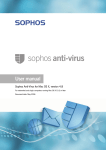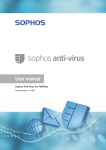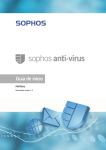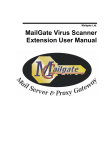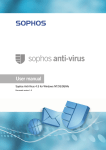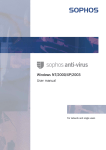Download Sophos Anti-Virus 4.5 for Mac OS X user manual
Transcript
User manual Sophos Anti-Virus 4.5 for Mac OS X For network and single users running Mac OS X 10.2 or later Document version 1.0 About this manual This user manual explains how to use Sophos Anti-Virus for Mac OS X, and how to configure • virus scanning • virus alerts • disinfection • reporting • notification • logging • updating. The manual also provides help in resolving common problems. If you are using Mac OS 8 or 9, refer instead to the Sophos Anti-Virus Mac OS 8 or 9 user manual. For information on the installation, initial setup, updating or uninstallation of Sophos Anti-Virus, see the Sophos Anti-Virus Enterprise Solutions startup guide. Sophos Anti−Virus 4.5 for Mac OS X Contents About Sophos Anti−Virus.....................................................................................1 Sophos Anti−Virus window...........................................................................1 Sophos Anti−Virus icon.................................................................................3 Using Sophos Anti−Virus.....................................................................................4 How to run an immediate scan.....................................................................4 How to change items for scanning................................................................5 How to see the results of a scan...................................................................6 How to start and stop on−access scanning..................................................6 Setting preferences...............................................................................................8 How to open the preferences pages.............................................................8 How to edit which file types Sophos Anti−Virus scans..................................9 How to edit disinfection preferences...........................................................11 How to edit reporting preferences...............................................................12 How to edit desktop alerts preferences.......................................................14 How to edit email notification preferences..................................................15 How to edit central notification preferences................................................17 How to edit logging preferences.................................................................18 How to restore the default preferences.......................................................20 Finding virus information...................................................................................22 How to find out about a virus via the Sophos Anti−Virus window...............22 How to find out about a virus via the on−screen log...................................22 How to find out about a virus via the web...................................................23 Disinfection..........................................................................................................24 How to set up automatic disinfection..........................................................24 How to carry out manual disinfection..........................................................26 Updating Sophos Anti−Virus..............................................................................27 How to update manually.............................................................................27 How to set up automatic updating...............................................................28 How to set a source for updates.................................................................29 How to set an alternative source for updates..............................................31 How to schedule updates............................................................................32 How to update via a proxy..........................................................................33 How to check the progress of an update....................................................34 How to receive desktop alerts about updates.............................................35 How to log updates.....................................................................................36 Troubleshooting..................................................................................................38 Updating fails to happen.............................................................................38 Document not disinfected...........................................................................39 Virus fragment reported..............................................................................39 Sophos Anti−Virus 4.5 for Mac OS X Using Sophos Anti−Virus via Terminal Troubleshooting Sophos Anti−Virus reports errors................................................................40 Using Sophos Anti−Virus via Terminal.............................................................41 About Sophos Anti−Virus Sophos Anti−Virus is software that detects viruses, worms and trojans on your computer or network. It can also disinfect infected items. In particular, it can • scan your computer or network for viruses • check each file you access for viruses • eliminate viruses • alert you when it finds a virus • keep a log of its activity • be updated to detect the latest viruses. Sophos Anti−Virus consists of two main components: • the Sophos Anti−Virus window • the Sophos Anti−Virus icon. Sophos Anti−Virus window To open the Sophos Anti−Virus window, in a Finder window, click Applications. Find and double−click Sophos Anti−Virus. The components of the window are described in the following sections. 1 Sophos Anti−Virus 4.5 for Mac OS X About Sophos Anti−Virus • Button bar • Scan list • On−screen log. To close the Sophos Anti−Virus window, on the Sophos Anti−Virus menu, click Quit Sophos Anti−Virus. Button bar In the Sophos Anti−Virus window, the buttons are shortcuts to commonly−used menu options. The button shown below starts scanning. The button shown below stops scanning. The button shown below opens a dialog box in which you can configure scanning. The button shown below connects you to virus analyses on the Sophos website. The button shown below opens the help system. Scan list In the Sophos Anti−Virus window, the scan list shows the drives, paths and files that can be scanned. 2 Sophos Anti−Virus 4.5 for Mac OS X About Sophos Anti−Virus On−screen log In the Sophos Anti−Virus window, the on−screen log contains all messages logged since the window was opened. The information is also added to the continuous log (see Logging preferences for immediate scanning). Sophos Anti−Virus icon The Sophos Anti−Virus icon is displayed in the system status bar, even if the Sophos Anti−Virus window is closed. The appearance of the icon changes depending on whether on−access scanning is active, whether Sophos Anti−Virus is updating and whether Sophos Anti−Virus updated successfully last time. While on−access scanning is active, the icon is blue. If you pass the mouse over the icon, the tool tip displays the status of updating. If you click the icon, a menu is displayed. From here, you can • update Sophos Anti−Virus • check the progress of an update • open the Sophos Anti−Virus window • configure on−access scanning, notification and updating • check the Sophos Anti−Virus version information. To prevent display of the Sophos Anti−Virus icon, open the Sophos Anti−Virus preferences pages (see How to open the preferences pages). Click the padlock icon and enter your username and password, so that you can make changes. In the Scanning tabbed page, on the Show pop−up menu, choose General. Deselect Show Sophos Anti−Virus icon in system status bar. 3 Using Sophos Anti−Virus This section describes how to • run an immediate scan • change items for scanning • see the results of a scan • start and stop on−access scanning. How to run an immediate scan An immediate scan is a virus scan of the computer, or parts of the computer, that you can carry out at any time. You run an immediate scan from the Sophos Anti−Virus window. The scan list shows items that can be included in scans. An indicator light to the left of an item indicates whether it is activated and will be scanned. Click the light to activate or deactivate items. Scanning all selected items To scan all the items selected for scanning in the scan list, click the button shown below. 4 Sophos Anti−Virus 4.5 for Mac OS X Using Sophos Anti−Virus Drag and Drop scanning To scan an item without adding it to the scan list, drag it from a Finder window onto the button shown below. Individual item scanning To scan an individual item in the scan list, double−click the item. (It need not be highlighted, nor does the indicator light to the left of the item need to be illuminated.). Cancelling scanning To cancel scanning, click the button shown below. How to change items for scanning You change items for immediate scanning from the Sophos Anti−Virus window. By default, all local hard drives and network volumes are included in the scan list, and are activated for scanning. You can change the items in the scan list as described below. 5 Sophos Anti−Virus 4.5 for Mac OS X Using Sophos Anti−Virus To add a disk, folder or file to the scan list, drag it from a Finder window into the scan list. Drag and Drop is the only way to add an individual file. To scan an item without adding it to the scan list, drag it from a Finder window onto the button shown below. To remove an item from the scan list, drag it to the Trash can. How to see the results of a scan You can see the results of a scan in the Sophos Anti−Virus window. Click the Details selector arrow in the bottom left of the window. This displays the on−screen log, which shows all scans performed, viruses found and errors encountered during the current session. This information is also added to the continuous log (see How to edit logging preferences). To clear the on−screen log, click Clear Log. If Sophos Anti−Virus reports a virus and you want information about it, double−click the line of text that contains the name of the virus. This takes you to specific information about the virus on the Sophos website (see Finding virus information). How to start and stop on−access scanning On−access scanning intercepts files as they are accessed, and grants access to only those that are virus free. If you installed on−access scanning as part of Sophos Anti−Virus, on−access scanning starts automatically when you start the computer. You can • check whether on−access scanning is running • start and stop on−access scanning. To check whether on−access scanning is running In the system status bar, look for the Sophos Anti−Virus icon. If on−access 6 Sophos Anti−Virus 4.5 for Mac OS X Using Sophos Anti−Virus scanning is running, the icon is blue. If it is not running, the icon is greyed out. To start and stop on−access scanning On the Apple menu, choose System Preferences. In the Other section of the System Preferences window, find the Sophos Anti−Virus icon and click it. Alternatively, in the system status bar, click the Sophos Anti−Virus icon to display a menu. Choose Open Preferences. In the Sophos Anti−Virus preferences pages, click the padlock icon and enter your username and password, so that you can make changes. In the Scanning tabbed page, on the Show pop−up menu, choose General. To start scanning, click Start. To stop scanning, click Stop. 7 Setting preferences This section describes how to set your preferences for • scanning • disinfection • reporting • desktop alerts • email notification • central notification • logging. It also describes how to restore default settings. How to open the preferences pages Sophos Anti−Virus has two sets of preferences pages: one for immediate scanning and one for on−access scanning, notification and updating. To view the pages for immediate scanning Open the Sophos Anti−Virus window. Click the button shown below. This returns you to the preferences page you last accessed. Each user on the computer can set different preferences for immediate scanning. To view the pages for on−access scanning, notification and updating On the Apple menu, choose System Preferences. In the Other section of the System Preferences window, find the Sophos Anti−Virus icon and click it. Alternatively, in the system status bar, click the Sophos Anti−Virus icon to display a menu. Choose Open Preferences. 8 Sophos Anti−Virus 4.5 for Mac OS X Setting preferences The Sophos Anti−Virus preferences pages are displayed. Click the padlock icon and enter your username and password, so that you can make changes. When you have finished making changes in the preferences pages, click the Set button to put them into effect. How to edit which file types Sophos Anti−Virus scans You set preferences separately for immediate and on−access scanning. Scanning preferences for immediate scanning Open the Immediate Scanning Preferences window (see How to open the preferences pages). On the Immediate Scan menu, choose Scanning Options. Scan inside archive and compressed files Select this to enable Sophos Anti−Virus to scan inside archive and compressed files. Scan mailboxes Select this to enable Sophos Anti−Virus to scan emails and attachments in Outlook Express mailboxes. 9 Sophos Anti−Virus 4.5 for Mac OS X Setting preferences Include non−Macintosh virus detection Select this to enable Sophos Anti−Virus to detect non−Mac viruses, as well as Mac and document viruses. Note that non−Mac viruses cannot infect Macs but can infect any non−Mac computers on the network. Scanning preferences for on−access scanning Open the Sophos Anti−Virus preferences pages (see How to open the preferences pages). Click the padlock icon and enter your username and password, so that you can make changes. In the Scanning tabbed page, on the Show pop−up menu, choose Scanning Options. Change the settings (described below) and then click Set to put them into effect. Scan inside archive and compressed files Select this to enable Sophos Anti−Virus to scan inside archive and compressed files. Detect non−Macintosh viruses Select this to enable Sophos Anti−Virus to detect non−Mac viruses, as well as Mac and document viruses. Note that non−Mac viruses cannot infect Macs but can infect any non−Mac computers on the network. 10 Sophos Anti−Virus 4.5 for Mac OS X Setting preferences How to edit disinfection preferences You set disinfection preferences separately for immediate and on−access scanning. Disinfection preferences for immediate scanning Open the Immediate Scanning Preferences window (see How to open the preferences pages). On the Immediate Scan menu, choose Disinfection. Enable Disinfection Select this to enable automatic disinfection of infected documents or program files found during scanning. Confirm Disinfection Select this to ensure Sophos Anti−Virus prompts for confirmation before it attempts disinfection. Action On Infected Files Select this to specify the action taken against infected files if you are not using automatic disinfection, or if disinfection fails. Sophos Anti−Virus can delete a file, move it to prevent it being run, or copy it to a specified folder for further analysis. Click Select to specify the folder where infected files are placed. 11 Sophos Anti−Virus 4.5 for Mac OS X Setting preferences Disinfection preferences for on−access scanning Open the Sophos Anti−Virus preferences pages (see How to open the preferences pages). Click the padlock icon and enter your username and password, so that you can make changes. In the Scanning tabbed page, on the Show pop−up menu, choose Disinfection. Change the settings (described below) and then click Set to put them into effect. Enable disinfection Select this to enable automatic disinfection of infected documents or program files found during scanning. Action on infected files Select this to specify the action taken against infected files if you are not using automatic disinfection, or if disinfection fails. Sophos Anti−Virus can delete a file, move it to prevent it being run, or copy it to a specified folder for further analysis. Click Select to specify the folder where infected files are placed. How to edit reporting preferences Reporting preferences are available for immediate scanning only. 12 Sophos Anti−Virus 4.5 for Mac OS X Setting preferences Open the Immediate Scanning Preferences window (see How to open the preferences pages). On the Immediate Scan menu, choose Reporting. Sophos Anti−Virus also maintains a continuous log of all scanning activity. See How to edit logging preferences. Enable reporting Select this to enable Sophos Anti−Virus to generate a report file each time an immediate scan is run. List infected files only By default, Sophos Anti−Virus reports infected files only. Deselect this option to enable Sophos Anti−Virus to report all files scanned. Report Filename You can enter a report filename in this text box. The default name is 'SAV Report'. Note that this file is overwritten each time a scan is run, unless a new filename is chosen for each report. Click Select to specify where the report file is stored. The default is the desktop of the user who is running Sophos Anti−Virus. Click Editor to choose the text editor with which the report file can be opened. The default is TextEdit. 13 Sophos Anti−Virus 4.5 for Mac OS X Setting preferences How to edit desktop alerts preferences You set desktop alerts preferences separately for immediate and on−access scanning. Alerts sent by immediate scanning Open the Immediate Scanning Preferences window (see How to open the preferences pages). On the Immediate Scan menu, choose Desktop alerts. Enable Desktop alerts Select this to enable Sophos Anti−Virus to display alerts in a pop−up box at the end of each immediate scan. There are two levels of alerting: If you click Viruses, Sophos Anti−Virus will warn you if it finds a virus. If you click Viruses and Errors, it will display both virus warnings and error messages. User−defined pop−up message In this text area, you can specify the text of the pop−up that will be displayed when Sophos Anti−Virus encounters viruses or errors. Alerts sent by on−access scanning Open the Sophos Anti−Virus preferences pages (see How to open the preferences pages). Click the padlock icon and enter your username and 14 Sophos Anti−Virus 4.5 for Mac OS X Setting preferences password, so that you can make changes. In the Scanning tabbed page, on the Show pop−up menu, choose Desktop Alerts. Change the settings (described below) and then click Set to put them into effect. Enable desktop alerts Select this to enable Sophos Anti−Virus to display alerts in a pop−up box. There are two levels of alerting: If you click Viruses, Sophos Anti−Virus will warn you if it finds a virus. If you click Viruses and errors, it will display both virus warnings and error messages. User−defined pop−up message In this text area, you can specify the text of the pop−up that will be displayed when Sophos Anti−Virus encounters viruses or errors. How to edit email notification preferences Macs can send virus reports for immediate and on−access scanning to an email address. 15 Sophos Anti−Virus 4.5 for Mac OS X Setting preferences Open the Sophos Anti−Virus preferences pages (see How to open the preferences pages). Click the padlock icon and enter your username and password, so that you can make changes. In the Notification tabbed page, on the Show pop−up menu, choose Email Notification. Change the settings (described below) and then click Set to put them into effect. Enable immediate scanner email notification Select this to enable Sophos Anti−Virus to send virus reports during immediate scanning. Enable on−access scanner email notification Select this to enable Sophos Anti−Virus to send virus reports during on−access scanning. Recipient In this text box, type the email address of the recipient of the virus reports. Sender In this text box, type the email address of the sender of the virus reports. 16 Sophos Anti−Virus 4.5 for Mac OS X Setting preferences Outgoing mail server In this text box, type the address of the server that sends the virus reports. Port In this text box, type the port on the Mac that is used to send virus reports. Viruses Select this to enable Sophos Anti−Virus to send virus reports if it finds a virus. Viruses and errors Select this to enable Sophos Anti−Virus to send virus reports if it finds a virus or there is an error. How to edit central notification preferences If a version of Sophos Anti−Virus that supports InterCheck Server mode (for central messaging) is running on the network, Macs can send virus reports for immediate and on−access scanning to a central location. Open the Sophos Anti−Virus preferences pages (see How to open the preferences pages). Click the padlock icon and enter your username and password, so that you can make changes. In the Notification tabbed page, on the Show pop−up menu, choose InterCheck Server. Change the settings (described below) and then click Set to put them into effect. 17 Sophos Anti−Virus 4.5 for Mac OS X Setting preferences Enable central reporting of viruses to an InterCheck server Select this to enable Sophos Anti−Virus to send virus reports to a central folder. Network share In this text box, type the network address of the InterCheck Server network share. In the User name and Password text boxes, type credentials needed to access the share. How to edit logging preferences You set preferences separately for immediate and on−access scanning. Logging preferences for immediate scanning Sophos Anti−Virus maintains a continuous log of all immediate scanning activity, including viruses found, which is written to a log file on disk. To configure this file, open the Immediate Scanning Preferences window (see How to open the preferences pages). On the Immediate Scan menu, choose Log File. By default the log is a file called "Sophos Anti−Virus Log.rtf". 18 Sophos Anti−Virus 4.5 for Mac OS X Setting preferences The log file cannot be disabled. Location of the Sophos Anti−Virus Log file Click Select to specify a folder for the log file. By default, it is placed on the desktop of the user who is running Sophos Anti−Virus. Click Editor to choose the editor in which you will view the log file. The default is TextEdit. Click Purge Log File to purge the contents of the log file. Logging preferences for on−access scanning Open the Sophos Anti−Virus preferences pages (see How to open the preferences pages). Click the padlock icon and enter your username and password, so that you can make changes. In the Scanning tabbed page, on the Show pop−up menu, choose Logging. Change the settings (described below) and then click Set to put them into effect. 19 Sophos Anti−Virus 4.5 for Mac OS X Setting preferences Logging into system log Select this to enable Sophos Anti−Virus to log all on−access scanning activity, including viruses found, in the system log. Logging into a file Select this to enable Sophos Anti−Virus to log all on−access scanning activity, including viruses found, in a log file on disk. Click Select to specify the folder for the log file. The default is the Logs folder. In the File name text box, type the log file name. The default is "Sophos Anti-Virus Log.txt". Click View Log File to view the log file in a separate window. Click Purge Log File to purge the contents of the log file. How to restore the default preferences Immediate scanning To restore the default preferences for immediate scanning, on the Special menu, choose Restore Defaults. 20 Sophos Anti−Virus 4.5 for Mac OS X Setting preferences On−access scanning, notification and updating To restore the default preferences for on−access scanning, notification and updating, open the Sophos Anti−Virus preferences pages (see How to open the preferences pages). Click the padlock icon and enter your username and password, so that you can make changes. Click Defaults. 21 Finding virus information Sophos Virus info is the area of the Sophos website that includes information about common viruses and how to disinfect them. You can access it by browsing the Sophos website, or via the Sophos Anti−Virus window. This section describes how to access Sophos Virus info. How to find out about a virus via the Sophos Anti−Virus window To open Sophos Virus info, open the Sophos Anti−Virus window. Then click the button shown below. Alternatively, with the Sophos Anti−Virus window open, on the Special menu, choose Virus Info. At the resulting prompt, make your choice. If you click Continue, you are taken to the virus information section of the Sophos website. How to find out about a virus via the on−screen log In the Sophos Anti−Virus window, click Details to display the on−screen log. If a virus has been reported, double−click the line containing the name of the virus. 22 Sophos Anti−Virus 4.5 for Mac OS X Finding virus information At the resulting prompt, make your choice. If you select Continue, you are taken to the virus information section of the Sophos website. How to find out about a virus via the web To go directly to the virus information section of the Sophos website, go to www.sophos.com/virusinfo/analyses and search for information on the virus. 23 Disinfection This section describes how to • set up automatic disinfection • carry out manual disinfection. How to set up automatic disinfection Sophos Anti−Virus can disinfect infected documents or program files automatically. You set disinfection preferences separately for immediate and on−access scanning. Disinfection preferences for immediate scanning Open the Immediate Scanning Preferences window. On the Immediate Scan menu, choose Disinfection. Enable Disinfection Select this to enable automatic disinfection of infected documents or program files found during scanning. 24 Sophos Anti−Virus 4.5 for Mac OS X Disinfection Confirm Disinfection Select this to ensure Sophos Anti−Virus prompts for confirmation before it attempts disinfection. Action On Infected Files Select this to specify the action taken against infected files if you are not using automatic disinfection, or if disinfection fails. Sophos Anti−Virus can delete a file, move it to prevent it being run, or copy it to a specified folder for further analysis. Click Select to specify the folder where infected files are placed. Disinfection preferences for on−access scanning Open the Sophos Anti−Virus preferences pages. Click the padlock icon and enter your username and password, so that you can make changes. In the Scanning tabbed page, on the Show pop−up menu, choose Disinfection. Change the settings (described below) and then click Set to put them into effect. Enable disinfection Select this to enable automatic disinfection of infected documents or program files found during scanning. 25 Sophos Anti−Virus 4.5 for Mac OS X Disinfection Action on infected files Select this to specify the action taken against infected files if you are not using automatic disinfection, or if disinfection fails. Sophos Anti−Virus can delete a file, move it to prevent it being run, or copy it to a specified folder for further analysis. Click Select to specify the folder where infected files are placed. How to carry out manual disinfection If you have not enabled automatic disinfection, or if Sophos Anti−Virus cannot disinfect the infected file, attempt manual disinfection, as follows. Isolate infected computers from the network and internet. Write down the name of the virus. Then, from an uninfected computer, look up its virus analysis on the Sophos website. www.sophos.com/virusinfo/analyses The analysis provides information about the virus and how to disinfect it. It may include a link to detailed disinfection instructions. If there are no instructions, or the virus analysis tells you to seek advice, contact Sophos technical support. 26 Updating Sophos Anti−Virus Sophos Anti−Virus must be updated regularly to enable it to detect all the latest viruses. If your computer is on a network, or if your administrator has installed Sophos Anti−Virus for you, Sophos Anti−Virus has probably already been configured to update itself automatically. If you need to set up automatic updating, or want to change the updating settings, you can do so. This section describes how to: • update manually • set up automatic updating • set a source for updates • set an alternative source for updates • schedule updates • update via a proxy • check the progress of an update • receive desktop alerts about updates • log updates. How to update manually If you have installed Sophos Anti−Virus as recommended in Sophos documentation, updating occurs automatically. If you have set up automatic updating, you can also update Sophos Anti−Virus manually. Locate the Sophos Anti−Virus icon in the system status bar (shown below). Click it and choose Update Now. Provided Sophos Anti−Virus has been correctly configured, it checks the usual source for new software and, if necessary, updates itself. For information on configuring updating, see the other pages in this section. 27 Sophos Anti−Virus 4.5 for Mac OS X Updating Sophos Anti−Virus How to set up automatic updating If your computer is on a network, or if your administrator installed Sophos Anti−Virus for you, Sophos Anti−Virus has usually been set to update itself automatically. If automatic updating has not been set up, follow the steps below. For full information on the options at each step, see the section describing that configuration page. Open the Sophos Anti−Virus preferences pages (see How to open the preferences pages). Click the padlock icon and enter your username and password, so that you can make changes. In the AutoUpdate tabbed page, on the Show pop−up menu, choose Network Settings. Click the Primary Server tab. Set the source for updates (see How to set a source for updates). Your administrator gives you the details you need to enter. On the Show pop−up menu, choose Scheduling and schedule updates (see How to schedule updates). 28 Sophos Anti−Virus 4.5 for Mac OS X Updating Sophos Anti−Virus How to set a source for updates If you want Sophos Anti−Virus to update itself automatically, you must specify where it fetches updates from. Open the Sophos Anti−Virus preferences pages (see How to open the preferences pages). Click the padlock icon and enter your username and password, so that you can make changes. In the AutoUpdate tabbed page, on the Show pop−up menu, choose Network Settings. Click the Primary Server tab. Change the settings (described below) and then click Set to put them into effect. 29 Sophos Anti−Virus 4.5 for Mac OS X Updating Sophos Anti−Virus Your administrator supplies you with the address and account details you need. Sophos Click this to enable Sophos Anti−Virus to download updates directly from Sophos via the internet. Company web server Click this to enable Sophos Anti−Virus to download updates from your company web server. Type the web address in the URL text box. Network volume Click this to enable Sophos Anti−Virus to download updates from your company network. Type the network address in the URL text box. User name If necessary, type the User name for the account that will be used to access the update source you have selected, and then enter the Password. If you access the internet via a proxy server, click the Primary Proxy tab. Note that some internet service providers require web requests to be sent to a proxy server. 30 Sophos Anti−Virus 4.5 for Mac OS X Updating Sophos Anti−Virus How to set an alternative source for updates You can set an alternative source for updates. If Sophos Anti−Virus cannot contact its usual source, it will attempt to update from this alternative source. Open the Sophos Anti−Virus preferences pages (see How to open the preferences pages). Click the padlock icon and enter your username and password, so that you can make changes. In the AutoUpdate tabbed page, on the Show pop−up menu, choose Network Settings. Click the Secondary Server tab. Change the settings (described below) and then click Set to put them into effect. Your administrator supplies you with the address and account details you need. Use secondary server Select this to enable Sophos Anti−Virus to update from this alternative source. Sophos Click this to enable Sophos Anti−Virus to download updates directly from Sophos via the internet. 31 Sophos Anti−Virus 4.5 for Mac OS X Updating Sophos Anti−Virus Company web server Click this to enable Sophos Anti−Virus to download updates from your company web server. Type the web address in the URL text box. Network volume Click this to enable Sophos Anti−Virus to download updates from your company network. Type the network address in the URL text box. User name If necessary, type the User name for the account that will be used to access the update source you have selected, and then enter the Password. If you access the internet via a proxy server, click the Secondary Proxy tab. Note that some internet service providers require web requests to be sent to a proxy server. How to schedule updates You can specify when or how often Sophos Anti−Virus updates itself. Open the Sophos Anti−Virus preferences pages (see How to open the preferences pages). Click the padlock icon and enter your username and password, so that you can make changes. In the AutoUpdate tabbed page, on the Show pop−up menu, choose Scheduling. Change the settings (described below) and then click Set to put them into effect. 32 Sophos Anti−Virus 4.5 for Mac OS X Updating Sophos Anti−Virus If you want Sophos Anti−Virus to update itself at regular intervals, select Every and enter the time period. If you want Sophos Anti−Virus to update itself every time a network connection is established, select When connection is made to network/internet. How to update via a proxy If Sophos Anti−Virus fetches updates via the internet, you must enter details of any proxy server that you use to connect to the internet. Open the Sophos Anti−Virus preferences pages (see How to open the preferences pages). Click the padlock icon and enter your username and password, so that you can make changes. In the AutoUpdate tabbed page, on the Show pop−up menu, choose Network Settings. Click the Primary Server tab or the Secondary Server tab as required. Ensure that all the details have been correctly entered. Then click the Primary Proxy tab or the Secondary Proxy tab as required. Change the settings (described below) and then click Set to put them into effect. 33 Sophos Anti−Virus 4.5 for Mac OS X Updating Sophos Anti−Virus Use system proxy settings Click this to enable Sophos Anti−Virus to use the proxy settings that have been set up in the system preferences. Use custom proxy settings Click this to enable Sophos Anti−Virus to use the proxy settings that you enter on this tabbed page. Type the settings in the Address, Port, User name and Password text boxes. Do not use proxy Click this if you don't want Sophos Anti−Virus to connect via a proxy. How to check the progress of an update Locate the Sophos Anti−Virus icon in the system status bar (shown below). Click it and choose Show AutoUpdate Window. 34 Sophos Anti−Virus 4.5 for Mac OS X Updating Sophos Anti−Virus See also How to receive desktop alerts about updates and How to log updates. How to receive desktop alerts about updates You can configure Sophos Anti−Virus to display desktop alerts during updating. These alerts are displayed only if AutoUpdate Status is not displayed. Open the Sophos Anti−Virus preferences pages (see How to open the preferences pages). Click the padlock icon and enter your username and password, so that you can make changes. In the AutoUpdate tabbed page, on the Show pop−up menu, choose Desktop Alerts. Change the settings (described below) and then click Set to put them into effect. Enable desktop alerts Select this to enable Sophos Anti−Virus to display alerts in a pop−up box. There are two levels of alerting: 35 Sophos Anti−Virus 4.5 for Mac OS X Updating Sophos Anti−Virus If you click Errors, Sophos Anti−Virus will display only messages about updating errors. If you click Errors and status messages, it will display messages about updating errors and progress. How to log updates You can configure Sophos Anti−Virus to record updating activity in a log file. Open the Sophos Anti−Virus preferences pages (see How to open the preferences pages). Click the padlock icon and enter your username and password, so that you can make changes. In the AutoUpdate tabbed page, on the Show pop−up menu, choose Logging. Change the settings (described below) and then click Set to put them into effect. Logging into system log Select this to enable Sophos Anti−Virus to log all updating activity in the system log. Logging into a file Select this to enable Sophos Anti−Virus to log all updating activity in a log file on disk. 36 Sophos Anti−Virus 4.5 for Mac OS X Updating Sophos Anti−Virus Click Select to specify the folder for the log file. The default is the Logs folder. In the File name text box, type the log file name. The default is "Sophos AutoUpdate Log.txt". Click View Log File to view the log file in a separate window. Click Purge Log File to purge the contents of the log file. 37 Troubleshooting This section provides answers to some common problems that you may encounter when using Sophos Anti−Virus. If your problem is not described in here, refer to the Sophos website www.sophos.com which includes technical support information, virus analyses and technical articles. If your problem is not described on the website, contact Sophos technical support. Updating fails to happen To find out more about an update failure, look at the update log, as follows. Open the Sophos Anti−Virus preferences pages (see How to open the preferences pages). In the AutoUpdate tabbed page, on the Show pop−up menu, choose Logging. Click View Log File. The sections below explain why updating may fail, and how you can change the settings to correct the problem. Sophos Anti−Virus contacts the wrong source for updates Open the Sophos Anti−Virus preferences pages (see How to open the preferences pages). Click the padlock icon and enter your username and password, so that you can make changes. In the AutoUpdate tabbed page, on the Show pop−up menu, choose Network Settings. Click the Primary Server tab. Check that the address and account details are those supplied by your administrator (see How to set a source for updates). Click Set to put them into effect. Sophos Anti−Virus cannot use your proxy server If your copy of Sophos Anti−Virus updates itself via the internet, you must ensure that it can use your proxy server (if there is one). Open the Sophos Anti−Virus preferences pages (see How to open the preferences pages). Click the padlock icon and enter your username and password, so that you can make changes. In the AutoUpdate tabbed page, on the Show pop−up menu, choose Network Settings. Click the Primary Proxy tab. Enter the proxy server address and port number, and the account details (see How to update via a proxy). Click Set to put them into effect. 38 Sophos Anti−Virus 4.5 for Mac OS X Troubleshooting Automatic updating is not correctly scheduled Open the Sophos Anti−Virus preferences pages (see How to open the preferences pages). Click the padlock icon and enter your username and password, so that you can make changes. In the AutoUpdate tabbed page, on the Show pop−up menu, choose Scheduling. Choose the scheduling options you require (see How to set up automatic updating). Click Set to put them into effect. The source for updates is not being maintained Your company may have moved the folder (on the network or on a web server) from which you should update. Alternatively, it may not be maintaining the folder. If you think this may be the case, contact your network administrator. Document not disinfected Sophos Anti−Virus may report that an infected document has not been disinfected. This could be because • the infected item is on a write−protected disk or removable medium • Sophos Anti−Virus has discovered a virus fragment rather than an active virus. Remember that automatic disinfection is available only if it has been enabled. Disinfection is configured separately for immediate and on−access scanning. See How to edit disinfection preferences. Virus fragment reported If a virus fragment is reported, contact Sophos technical support for advice. The report of a virus fragment indicates that part of a file matches part of a virus. There are three possible causes: Variant of a known virus Many new viruses are based on existing ones, so that code fragments typical of a known virus may appear in files infected with a new one. If a virus fragment is reported, it is possible that Sophos Anti−Virus has detected a new virus, which could become active. 39 Sophos Anti−Virus 4.5 for Mac OS X Troubleshooting Corrupted virus Many viruses contain bugs in their replication routines that cause them to infect target files incorrectly. An inactive portion of the virus (possibly a substantial part) may appear within the host file, and this is detected by Sophos Anti−Virus. A corrupted virus cannot spread. Database containing a virus When running a full scan, Sophos Anti−Virus may report that there is a virus fragment in a database file. Sophos Anti−Virus reports errors After a scan, Sophos Anti−Virus may report that some errors were found. There are two main reasons for errors: File is corrupt Sophos Anti−Virus therefore cannot scan the file. File is encrypted If the file contains macros (e.g. it is a .doc or .xls file), only the main body of the file will have been encrypted (not the macros). You may be warned that the file is encrypted, but the parts of the file that can contain macro viruses are still scanned. 40 Using Sophos Anti−Virus via Terminal You can run immediate scans via Terminal, Mac OS X's command line interface. To do this, do as follows. In a Finder window, click Applications. Then click Utilities. Double−click Terminal to open Terminal. At the prompt, enter sweep −h to display a list of command line options that can be used with the sweep command. 41 Sophos Anti-Virus 4.5 for Mac OS X Technical support For technical support information visit www.sophos.com/support If you contact technical support, provide as much information as possible, including Sophos software version number(s), operating system(s) and patch level(s), and the exact text of any error messages. Copyright © 2004 by Sophos Plc All rights reserved. No part of this publication may be reproduced, stored in a retrieval system, or transmitted, in any form or by any means, electronic, mechanical, photocopying, recording or otherwise unless you are either a valid licensee where the documentation can be reproduced in accordance with the licence terms or you otherwise have the prior permission in writing of the copyright owner. Any name should be assumed to be a trademark unless stated otherwise. InterCheck and Sophos are registered trademarks of Sophos Plc. 200411 42














































